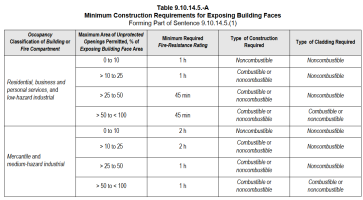I am confused!

The tests referred to in 9.10.3.1 are regarding FRR, not temp. rise limitations.
Is it trying to say that if the building has a LD of more than 1.2m there is no FRR required for the exterior walls? If so, this would contradict 9.10.14.5, which shows a minimum 45min FRR for all exterior walls:

When I go to 3.1.7.2 for clarification, I get more confused.

The tests referred to in 9.10.3.1 are regarding FRR, not temp. rise limitations.
Is it trying to say that if the building has a LD of more than 1.2m there is no FRR required for the exterior walls? If so, this would contradict 9.10.14.5, which shows a minimum 45min FRR for all exterior walls:

When I go to 3.1.7.2 for clarification, I get more confused.

